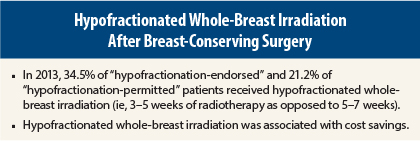In a study reported in JAMA, Justin E. Bekelman, MD, of the University of Pennsylvania Perelman School of Medicine, and colleagues found that approximately two-thirds of patients with early-stage breast cancer for whom hypofractionated whole-breast irradiation (for 3–5 weeks) was endorsed received conventional whole-breast irradiation (for 5–7 weeks) after breast-conserving surgery.1 Health-care expenditures were significantly lower for patients receiving hypofractionated whole-breast irradiation.
In 2011, the American Society for Radiation Oncology (ASTRO) practice guidelines endorsed hypofractionated whole-breast irradiation as being of equal effectiveness for in-breast tumor control and comparable with regard to long-term adverse effects compared with conventional whole-breast irradiation in patients with early-stage breast cancer who are at least 50 years old, have pathologic stage T1 or T2N0 disease, have no prior chemotherapy, and have radiation dose heterogeneity higher or lower than 7% of prescription dose.2 The guidelines also permitted hypofractionated whole-breast irradiation for other patients with early-stage breast cancer, including those younger than age 50.
Study Details
In this retrospective observational cohort study, administrative claims data from 14 commercial health-care plans covering 7.4% of U.S. adult women in 2013 were used to classify patients with incident early-stage breast cancer treated with lumpectomy and whole-breast irradiation from 2008 and 2013 into a hypofractionation-endorsed cohort (n = 8,924) and a hypofractionation-permitted cohort (n = 6,719). The hypofractionation-endorsed cohort included patients 50 years of age and older without prior chemotherapy or axillary lymph node involvement, and the hypofractionation-permitted cohort included patients younger than 50 years of age or those with prior chemotherapy or axillary lymph node involvement.
Hypofractionated whole-breast irradiation was defined as 11 to 24 fractions (3–5 weeks of whole-breast irradiation), and conventional whole-breast irradiation was defined as 25 to 40 fractions (5–7 weeks of whole-breast irradiation). Uptake of and costs associated with hypofractionated whole-breast irradiation were assessed for 2008 through 2013, covering the years before and after the release of the ASTRO guidelines.
Use of hypofractionated vs conventional whole-breast irradiation was analyzed using multivariable logistic regression, with adjustment for patient, clinical, demographic, and contextual variables, including year of treatment, age, comorbid disease, history of chemotherapy before and after lumpectomy, axillary lymph node involvement, practice setting, use of intensity-modulated radiotherapy, density of radiation oncologists by hospital service area, population density of county of residence, median household income, and level of educational attainment.
In the hypofractionation-endorsed cohort, the mean age was 62.7 years, and 66.0% of patients were younger than age 65. In the hypofractionation-permitted cohort, the mean age was 52.7 years, 47.0% were younger than age 50, 20.4% had axillary lymph node involvement, 10.6% received chemotherapy prior to surgery, and 59.6% received chemotherapy prior to whole-breast irradiation.
Increasing Use
Use of hypofractionated whole-breast irradiation increased from 10.6% (95% confidence interval [CI] = 8.8%–12.5%) in 2008 to 34.5% (95% CI = 32.2%–36.8%) in 2013 in the hypofractionation-endorsed cohort (adjusted odds ratio [OR] per year = 1.4, P < .001) and from 8.1% (95% CI = 6.0%–10.2%) in 2008 to 21.2% (95% CI = 18.9%–23.6%) in 2013 (adjusted OR per year = 1.3, P < .001) in the hypofractionation-permitted cohort.
In adjusted analyses, younger women were less likely to receive hypofractionated whole-breast irradiation in the hypofractionation-endorsed cohort, with the modality being used in 15.4% of those aged 50 to 54 years, 23.5% of those aged 70 to 74 years (P < .001), and 29.4% of those older than age 75 (P < .001). Age was not significantly associated with use of hypofractionated whole-breast irradiation in the hypofractionation-permitted cohort.
In the hypofractionation-endorsed cohort, use of hypofractionated whole-breast irradiation was more likely in the hospital outpatient setting vs freestanding facilities (21.6% vs 17.5%, adjusted OR = 1.4, P < .001). Use of intensity-modulated radiotherapy vs no intensity-modulated radiotherapy was associated with a significantly greater likelihood of use of hypofractionated whole-breast irradiation in both the hypofractionation-endorsed cohort (27.1% vs 19.5%, adjusted OR = 1.5, P < .001) and the hypofractionation-permitted cohort (18.2% vs 12.2%, adjusted OR = 1.6, P < .001).
Costs
Adjusted mean total health-care expenditures (adjusted for inflation to 2013) in the 1 year after diagnosis were $28,747 for hypofractionated whole-breast irradiation and $31,641 for conventional whole-breast irradiation in the hypofractionation-endorsed cohort (difference = $2,894, P < .001) and $64,273 for hypofractionated whole-breast irradiation and $72,860 for conventional whole-breast irradiation in the hypofractionation-permitted cohort (difference = $8,587, P < .001). Estimated savings with hypofractionated whole-breast irradiation were 9.1% in the hypofractionation-endorsed cohort and 11.8% in the hypofractionation-permitted cohort. There were no differences in mean total patient out-of-pocket expenses between hypofractionated and conventional whole-breast irradiation in either cohort.
Adjusted mean radiotherapy-related expenditures within the 3.5-month radiation period were significantly lower for hypofractionated whole-breast irradiation than for conventional whole-breast irradiation in both the hypofractionation-endorsed cohort ($12,622 vs $16,961, difference = $4,338, P < .001) and the hypofractionation-permitted cohort ($14,974 vs $19,762, difference = $4,785, P < .001). Patient out-of-pocket radiotherapy-related expenses were lower with hypofractionated whole-breast irradiation in both cohorts ($617 vs $746, P < .001; $519 vs $619, P = .04).
The investigators concluded: “Hypofractionated whole-breast irradiation after breast-conserving surgery increased among women with early-stage breast cancer in 14 U.S. commercial health-care plans between 2008 and 2013. However, only 34.5% of patients with hypofractionation-endorsed and 21.2% with hypofractionation-permitted early-stage breast cancer received hypofractionated whole-breast irradiation in 2013.” ■
Disclosure: For full disclosures of the study authors, visit jama.jamanetwork.com.
References
1. Bekelman JE, Sylwestrzak G, Barron J, et al: Uptake and costs of hypofractionated vs conventional whole breast irradiation after breast conserving surgery in the United States, 2008-2013. JAMA 312:2542-2550, 2014.
2. Smith BD, Bentzen SM, Correa CR, et al: Fractionation for whole breast irradiation: An American Society for Radiation Oncology (ASTRO) evidence-based guideline. Int J Radiat Oncol 81:59-68, 2011.
See commentary by Lori J. Pierce, MD, here.



